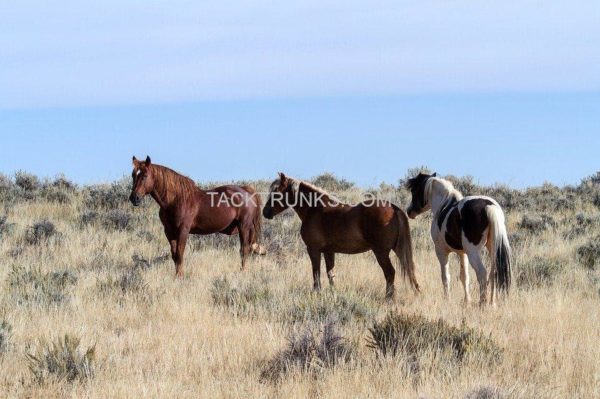
The History of Horses in North America
The image of a wild horse, free and running through a rugged landscape, has long been the symbol of the American West. This is echoed in our film and literature and contributes to the idea of America as a bold new landscape. However, much of the history of wild horses in America is disputed. The origin of this species is a debate that looks not only at the deep history of our planet, but also the claims to land management and ecology that various organizations and communities are involved in, to this day.
The once common idea that horses arrived in the “New World’ via Columbus in 1492, has now been discussed in several publications that look at the prehistoric records of North America. Wild horses have always been a part of the North American landscape. It is the question of whether or not this animal is “native” or introduced to the landscape that haspeople looking closer at this narrative.
Modern horses belong to the genus Equus, the only surviving genus in a once diverse family, the Equidae. Based on the fossil record, the Equus genus developed in North America about 4 million years ago. The species then crossed over to Eurasia, via the Bering Land Straight, about 2 to 3 million years ago. In North America, the last prehistoric horse species (Equus occidentalis, or the Western Horse) went extinct at the end of the last Ice Age (about 11,000-12,000 years ago).
The horse species that we are familiar with today is called E. callabus. When it was coined by “the father of modern taxonomy,” Carl Linnaeus, he was thinking of the domesticated species. The species E. ferus is commonly considered the wild ancestor of these animals that we see today. But there is no evidence in the fossil record to show that E. callabus and E. ferus are different species.
It is likely that as horses spread across the world due to the Bering Land Strait, and subsequently bred over thousands of years, the domesticated species arose over several different times in various locations. Researchers have been looking at new tools for finding out the exact relationships between the different horse species, in order to determine where the animal diverged from its paleontological history.
Genetic analyses, carried out by the San Diego Zoo’s Center for Reproduction in Endangered Species, indicated several different forms of wild E. callabus at 20,000-30,000 years ago. These studies show that even though this is not where the species originated from, there was a lot of genetic divergence within the species at that time. Mitochondrial DNA analysis studies have shown that E. callabus species had originated in the North American continent about 1.7 million years ago. Additionally, Ann Forsten-of the Zoological Institute of Helsinki, examined a sample of mtDNA (or mitochondrial DNA) from the species E. lambei and found that it is genetically similar to E. callabus.
These findings show us that the “domesticated” horse that Linnaeus coined as E. callabus, was already within that genetic strain before the reintroduction of the species to North America. The molecular biology, in the case of E. callabus, agrees with the interpretation of the fossil record.
However, the fossil record is not the only record to show horses in the North American continent. From American Indigenous historians like Yvette Running Horse Collins, the study of horses still coexisting with native peoples long before European contact is a new avenue of archaeological and indigenous research.
Collins reaffirms a Native American claim that the prehistoric horses did not in fact, go extinct after the last Ice Age and that early Indigenous peoples had a relationship with these horses. In this investigation, Critical Indigenous Research Methodology and Grounded Theory are used to determine the record of horses interacting with humans in early continental history.
Collins draws from the documentation that early Spanish colonizers recorded when they arrived in the Americas. These early records denote that the first sightings of Native people with horses occurred in 1521. Interestingly enough, there are no records stating that any Spanish horses were stolen by Native peoples at this time.
From interviewing American Indian study participants from different Nations, Collins reported that each of the communities claimed having horses prior to European arrival. Each community had an oral story, in the form of a traditional creation story, that explained the sacred horse within their society.
Recent findings of other Pleistocene fossils with human carvings on them, dating to 130,000 years ago, suggest that human societies have been in the Americas for longer than previously thought. This could also point to longer relationships with the Equus genus.
The narrative of Europeans bringing the horses to America is synonymous with the history of the American west and the arrival of the Spanish conquistadors. The sturdy horses from places like Spain and Portugal carried the settlers across the continent as they developed “pueblos” in the 1600s. Some of these ranching horses escaped into the wild and ended up breeding with the horses that had already been living in North America with the Native population.
These horses ended up becoming the free-running “mustangs” of the modern American west. These escaped Spanish breeds grazed freely on the plains and roamed across the landscape. At one point there were millions of wild horse herds across the United States. Due to the harsh weather and conditions of the land, many of these horses became smaller in size over time.
Wild horses today are considered “feral”, and it is implied within the use of that word to mean “invasive or intrusive.” The debate surrounding native and non-native species is detrimental to the conservation of natural habitats. So, when researchers and landowners alike look to classifying a species as “native” or “introduced,” they must consider where the species originated from and how it impacts the environment in which they exist in.
In the case of E. callabus, all of the genetic studies, the fossil record, and the recent work into the anthropological and archaeological studies, show that this animal has been in America for a long time. The fact that they were domesticated before being brought back to the continent means little, when comparing the DNA and the behavior of the species.
“Going wild” is referred to the phenomenon that a species will revert back to its ancient behavioral patterns once released into the wild. When domestic horses were released, reemergence of primitive behaviors occurred, indicating that the “domestication” was quite shallow in horses. Clearly, domestication altered little biology in the case of E. callabus.
So, what does it really mean, when terms like “native” and “feral” are applied to a species? We can think about the impact on habitats, the taxonomic history of an animal or the way that the species behaves when measured against human history. However, we must also place into context, what the species reflects on society today.
Wild horses were very nearly driven to the edge by American society. By the late 1960’s, there were only about 17,000 of them roaming across the fields of the American west. More than a million were conscripted for use in World War I combat. Others were hunted for meat for feed companies, or for sport. They were chased to the brink and it wouldn’t be until 1971 when federal regulations began to be put into place that allowed for the species to repopulate.
In 1971, a federal law was passed that banned capturing harming or killing free-roaming horses on public land. This was one step into determining the value of this animal, and the beginning of classifying it as a “native” species to be protected.
Today, there are about 60,000 wild horses that live on private ranches, wildlife refuges, and public land. All of the ranges are rough and wild land, so that the horses may return to prehistoric behavior patterns. There are still debates today, about whether or not the wild horse is “feral” or “native.”
A native status for these wild horses would mean that new categories of wildlife management must be taken into consideration. With a species that is as free-roaming and expansive as the wild horse, possible law must extend past state boundaries. Agencies now have to look at the value of the horse as a species to be protected, instead of as a species designed to have economic value.
With a “feral” status, then land management agencies are required to round up herds they deem are “too large.” This is backed up with the belief of maintaining and preserving an ecosystem. A species that negatively impact it, is now considered a nuisance to the conservationists.
There is clearly a divide in the characterization of this animal. A free-roaming spirit that idealizes the narrative of a continent is stuck in an impossible in-between space. When we look at the history of the species, including the fossil record and the human records, we are able to see it in its entirety. Perhaps even our own understanding of the term “native” will be reinterpreted as we study the history of the wild horse.


